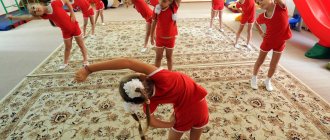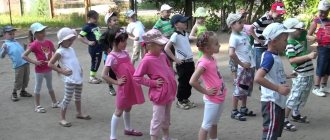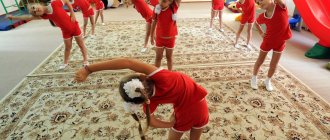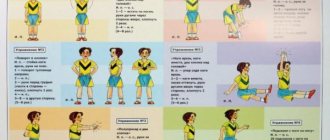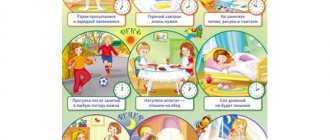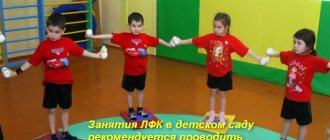Physical exercise is one of the principles of a healthy lifestyle. They are accustomed to them from a very young age. The mother does the first exercises for newborns together with the baby. Morning physical education helps the baby wake up, energizes him for the whole day, strengthens muscles and develops a sense of discipline. However, for gymnastics to really bring benefits and be a joy, you need to follow some rules.
At what age to start
Up to a year, mother and baby are engaged in what can be called preparation for real gymnastics: exercises for newborns up to a month include stroking and stretching, accompanied by poetry. They give the baby a positive experience from the contact between the mother and his own body.
Then passive gymnastics is added to the general strengthening massage for infants: the mother carefully bends and unbends, brings and spreads the arms and legs of the baby. You can also practice with your baby on a fitball.
Important! Before doing infant gymnastics, consult your pediatrician and take a few lessons from a professional massage therapist.
Basic rules for morning exercises for children
There are general rules that are always followed, regardless of age:
- exercises are done on an empty stomach, and to help the body wake up, you can first wash your face and drink a glass of water;
- the room should be well ventilated, it is even better to practice directly in the fresh air;
- most of the complex should consist of warm-up and stretching, and strength exercises should be avoided;
- watch your breathing: there should be no delays, there should be a rhythmic cycle of inhalation (through the nose) and exhalation (through the mouth).
- Hardening procedures (contrast shower or washing with cold water) and a healthy breakfast will help to consolidate the positive result.
In childhood, it is especially important that activities are interesting. Therefore, choose cheerful, upbeat music and change the exercises for children from time to time: add new movements, complicate them, come up with funny names for the exercises.
Gymnastics for children 6-9 months
In addition to the exercises already described:
Breathing exercises are done on your back, on your side, or start while sitting.
Simultaneous and alternate abduction of the arms to the sides, upwards, grasping movements with the arms.
All exercises for the legs are performed: “stomps”, sliding steps, circular movements of the legs, alternating flexion and extension.
A new exercise is introduced: cycling.
Starting position: on your back. With the child's legs bent at the hip and knee joints, circular movements are performed, reminiscent of the movement of the legs while riding a bicycle.
In a sitting position (in a tailor's position, when the feet are joined or in a Turkish position), the child is rocked using a toy and encouraged to stretch after it.
Try in every possible way to encourage your baby to actively turn from back to stomach and back.
An exercise aimed at developing crawling skills is useful. During this period of time, you can help the child by substituting your palm as a support.
Exercises are performed to develop walking: stepping from foot to foot is stimulated, while the adult first supports the child’s armpits, and subsequently, the hands of both hands.
In exercises on the ball: you can use swinging on it in a sitting position.
Warm-up
Warming up helps warm up the muscles and avoid subsequent pain. It is important to follow the correct order so that the load does not damage the children’s muscles and ligaments:
- start with fast walking;
- then load the arms, belt, back;
- the next part is strengthening the leg muscles;
- the active part includes running and jumping;
- finish with exercises to calm breathing: walking, inhaling and exhaling while raising your arms, etc.
Gymnastics for children 3-4 months old
In order to avoid repetition, we will add to the above exercises a description of new elements of gymnastics.
Breathing exercises
Starting position: on your back. Simultaneous movement of the arms up and down and circular movements with the arms are added.
Boxing exercise
Starting position: on your back. With your arms bent at the elbows, they are alternately straightened. The movements are reminiscent of boxing. Important! The handles are fixed in the wrist joints to prevent sprains.
Half-turns and turns from back to stomach and back
Starting position: on your back. One hand clasps the child's shins from below, the index finger of the adult's other hand is placed in the baby's palm, and the remaining fingers cover his hand. Then, slightly straightening the child’s legs, you should turn his pelvis, after which the child turns his head and shoulder girdle. Make turns in both directions in a similar manner.
Exercises on the ball
Starting from 3 months, you can introduce a new type of activity - exercises on the ball. For these exercises you will need a ball with a diameter of 50-60 cm, slightly deflated.
Swinging on the ball promotes the development of coordination, the vestibular apparatus, and helps to tone the abdominal muscles, back, and legs.
The baby is placed on the ball in different ways: on the back, on the tummy, and alternately on the sides.
Swings are performed with support on the legs, with legs raised.
It is important to remember to securely secure the child on the ball.
Children's exercises for children of different ages
If you start learning gymnastics from early childhood, then, most likely, in the future gymnastics will be perceived as an obligatory part of life. At the same time, it is important to correctly correlate the physical training complex and age.
1 year
The baby is not yet able to concentrate on one activity for a long time and is just learning to control his own body. Therefore, gymnastics is carried out for a short time, in a playful way and with the help of an adult. At an early age, exercise helps the baby to learn to sit independently, and later it helps to learn to crawl correctly and quickly.
The figure shows an example of such a complex for one year of age
By the age of one and a half years, you can add other movements:
- throwing the ball with two hands;
- make a “bicycle” with your legs with the help of an adult;
- walking along a narrow path and on an inclined plane;
- climbing through a hoop.
All movements should be presented in a playful, entertaining form so that they serve as a source of joy.
By the age of two, the baby will be able to make side turns from a standing position, jump on the spot, throw a ball into a basket or other target, and flap his arms “like wings.” Some of the exercises for children 2 years old can be done during a morning walk:
- climb up and down ladders;
- walk on a plank on the playground or along a chalk path;
- throw a ball at a target;
- run and jump.
2-3 years
For children 2-3 years old, it is very interesting to repeat the movements of adults, so it is better to do exercises for children 3 years old together with their parents. Class time at this age is 4-5 minutes. It is more interesting if the whole complex is carried out in the form of a game.
The figure shows an example of such a ball game complex:
The complex begins and ends with breathing exercises:
- Take a couple of deep breaths: inhale with the ball above your head, exhale in front of you.
- Moving your head up and down.
- Tilt down towards the ball.
- Bend to the sides with the ball raised above your head.
- Squats, you can hold the ball in your hands.
- Jumping on one leg, or, if the child has not yet mastered this skill, then on two.
- Running with knees raised.
- Normalization of breathing, 3-4 deep breaths.
4-6 years
Older preschoolers deftly control their own bodies, and they enjoy repeating quite complex movements after adults. Exercise for children 5 years old is also better done in a playful form, because play continues to be the main activity. The average duration of gymnastics is 8-10 minutes. Older preschoolers, like younger children, will do gymnastics in poetic form with interest; each movement is repeated 5-6 times.
The sequence will be like this:
- Exercises with a jump rope (grab the cord, calmly raise and lower your arms). On inhalation, the arms are raised, on exhalation, they are lowered.
- Bend over, holding a folded rope, hands up. The task is to touch the floor with the jump rope.
- Mill - rotation with hands back and forth.
- Turns left and right, hands on the belt.
- Squats.
- Lunges left and right.
- Jumping on two and one leg.
- Finish with breathing exercises. Take a deep breath, and as you exhale, make a long “kwaah.”
From the age of five, a preschooler becomes very dexterous and physically developed. And although one of the consequences of increased cognitive and physical activity is the crisis of 5 years, another side of development will be a large number of new skills. A five-year-old can easily be taught to ride a bicycle or rollerblade with pleasure. That is why for older preschoolers, daily exercise is simply necessary so that the muscles can cope with increased physical activity.
7-9 years
A morning physical education session will help a younger student feel more energetic, better adapt to school stress, and saturate the muscles with oxygen. Gymnastics is especially necessary for children who do not attend sports clubs. 10-15 minutes daily will be enough for the muscles to receive the necessary load and stretch.
A full complex consists of 12 exercises
It is good to do exercises accompanied by rhythmic music. At the same time, ensure correct posture and breathing so that the child does not hold his breath. Each exercise is repeated 8-10 times.
- Start by vigorously walking in place for about a minute.
- Alternate tilts of the head to the shoulder - 4-5 times in each direction. Make sure that the child does not make sudden movements and returns his head straight to its original position.
- One hand reaches up, the other down - stretch diagonally, repeat 8 times.
- Turn the body left and right, but the feet do not move.
- A mill with a tilted body 4 times in each direction. I.p. – the body is tilted forward, arms to the sides. Turns around the waist, while the arms remain in the same plane, the left hand reaches out to the right - and vice versa.
- Tilts with two hands touching, in turn, to each leg. To the left - they straightened up, to the right - they straightened up. Total – 8-10 tilts.
- Rising from a half-squat position, raising your arms up.
- Alternating straight leg raises with clapping underneath.
- Pushups.
- Turn the torso to the sides from a sitting position with straight legs, hands behind the head.
- Alternating straight leg raises from a sitting position.
- Jumping up with your arms raised.
The complex is completed with breathing exercises: from a standing position, while inhaling, slowly rise on tiptoes, count to 3, and lower your entire foot. As you exhale, bend down as low as possible, trying to touch your toes, count to 3, and return to the starting position.
Methodology for morning exercises for all age groups. Methodological development on the topic
Methodology for morning exercises for children of all age groups.
In the process of morning exercises, it is necessary to ensure the correct physical, mental and emotional stress. Physical activity increases gradually: having reached its highest value during jumping and running, it decreases towards the end of morning exercises. The motor density of morning exercises should be high, so minimal time is allocated for explaining and demonstrating exercises, distributing physical education equipment and changing lines. Physical activity increases by increasing the number of repetitions of each movement, the pace of their execution and reducing the interval between exercises. It also depends on the total duration of morning exercises: in the first junior group its duration is 4–5 minutes; in the second youngest - 5-6 minutes; on average - 6-8 minutes; in the eldest – 8–10 minutes; in preparatory school - 10-12 minutes.
Morning exercises use exercises familiar to children, so the mental load (on attention, memory) is almost always moderate. Physical exercise has a more beneficial effect on the body when it evokes a cheerful mood and positive emotions. And the teacher, correctly alternating exercises and giving sufficient load, creates interest in children in morning exercises. It is equally important to carry out the exercises emotionally, using various techniques and musical accompaniment. However, exercise and music should not overstimulate children because this can lead to fatigue and decreased appetite.
At the beginning of the year, children of the first junior group are not lined up before performing exercises: they walk and run in a flock, scattered. In the future, morning exercises in this group also begin with formation in a column, one at a time or in one line. Turns to the right, left, and around are more often used in older groups.
To perform general developmental exercises, young children are lined up in a circle, scattered; from the middle group they are usually rebuilt into a column of three or four. With this structure, it is easier for the teacher to monitor the quality of general developmental exercises performed by all children and to pay attention to correct posture.
At the beginning of morning exercises, walking in place is often given (regular, with high knees). This helps organize children and focus their attention.
To prevent flat feet, it is advisable to give different types of walking in the following combination at the beginning and at the end of morning exercises: normal walking, on toes, heels, and the edges of the feet. This combination is repeated 6–8 times.
It is useful to change your walking speed - from slow to fast, from fast to slow (with acceleration and deceleration).
It is necessary to ensure that children do not shuffle their feet or sway when walking, keep their heads straight, swing their arms rhythmically, and breathe through their nose. The teacher prevents mistakes with appropriate instructions, and if they do occur, corrects them without stopping walking.
When walking with high knees, imitation is used (“horses”, “herons”, “walking in deep snow”).
Running in morning exercises in younger groups is first carried out in a flock, scattered, and then in a column one at a time, both in place and with advancement in different directions.
Before general developmental exercises, running is performed at an average pace and alternates with walking. After performing general developmental exercises, running is carried out at a faster pace to train the cardiovascular and respiratory systems. The alternation of running and walking is repeated 2-3 times. The duration of running without a break gradually increases: for younger children it is 10–20 s, for middle age – 20–25 s, for older age – 25–30 s, for children 6 years old – 30–40 s (these norms can be changed depending on on the state of health, physical development, physical fitness of children). The teacher makes sure that indoors, on a playground with hard ground, children run on their toes, raising their knees higher.
Morning exercises include different types of jumps: jumping on one and two legs in place and moving in different directions (forward, backward, sideways, etc.); jumping over objects (sticks, hoops, cubes); For older children, the total number of jumps in morning exercises can be increased to 25–30. In younger groups, imitation (“bunnies”, “balls”) is used when jumping.
General developmental exercises for morning exercises are selected in the following sequence: first, exercises are given for the muscles of the arms and shoulder girdle, after which exercises that strengthen the muscles of the torso and legs are advisable.
At the end of the gymnastics, after running, alternating with jumping and walking, exercises can be performed for the shoulder girdle and arms, which help calm the body.
Exercises for large muscles (especially in older age) are combined with movements for the muscles of the neck, hands, fingers and feet. For example, when raising your arms up, it is recommended to simultaneously clench your hands into fists and unclench them.
The number of general developmental exercises and their dosage increase with the age of children, as physical development and physical fitness improve. For children of the first junior group, 3–4 exercises are recommended; for the second youngest – 4 and middle – 4–5; for the eldest – 5–6; for preparatory school – 6–8. In the first and second junior groups, the exercises are repeated 4–5 times; on average - 5-6 times; in the oldest – 6–8 times; in preparatory school - 8-10 times. In this case, exercises for the arms and shoulder girdle are repeated more times (8–10); and more difficult ones - for the abdominal muscles, back - 4-6 times.
Exercises can be performed at different paces, for example: first 2-3 times at a medium pace, then 3-4 times at a fast pace, then 2-3 times at a slow pace. This increases physical stress on the body, promotes the development of speed, and increases children’s interest in the activity.
General developmental exercises are performed from different starting positions of the body: standing, sitting, lying down (on the back, on the stomach). The starting positions of lying down and sitting are beneficial in that they relieve the pressure of body weight on the spine and fragile arch of the foot, and allow you to increase the tension of individual muscles. Therefore, during morning exercises, it is recommended to use chairs and gymnastic benches to perform exercises from starting positions while sitting. Exercises for the arms and shoulder girdle are performed by younger children from the starting position - narrow leg stand apart, and by older children - the main stand, closed stoic position.
Exercises for the trunk muscles at a younger age are carried out from the starting position: narrow leg stand apart, leg stand apart, and at an older age - leg stand apart, wide leg stand apart.
In leg exercises at a younger age, a narrow stance with legs apart is used, and at an older age, the main stance is used.
When conducting general developmental exercises with objects, you need to think through the order of their distribution and collection, and provide for the formation of the group so that the children do not interfere with each other.
At an older age, general developmental exercises without objects occupy a larger volume.
In younger groups, the teacher performs general developmental exercises with the children. In the middle group, he first names the exercise, briefly explains it (shows it if necessary), and then gives a command for the starting position and execution. When explaining, children's attention is fixed on the most difficult elements of the exercise. If errors do occur, instructions for correcting them are given during the exercise. Instructions should be aimed at clarifying the understanding of the elements of the exercise and facilitating their correct implementation. This is helped by combining counting with words denoting elements of the technique, or even replacing counting with specific words (for example, instead of “one”, the teacher says: “Squat down, back straight”).
The teacher must think about when he will use counting when repeating an exercise, and when he will replace it with words that clarify the idea of this element of technique. The appropriate alternation of counting, words (instructions) and other signals (moving the hand down - “crouched”, upward - “straightened up” in the “squat” exercise) helps children perform the movement more correctly and with great interest.
At an older age, children can do the exercise by name, but sometimes in the older group the teacher does the exercise together with the children. This reduces the reminder time and increases physical stress on the body. Following the teacher’s actions, children clarify their understanding of movement technique and try to correct mistakes. But such a joint exercise is only advisable if the teacher sees the whole group and can observe the actions of the children and their behavior (when bending to the sides, when squatting, etc.). Sometimes a child who does the exercises correctly is placed at the front of the group.
During morning exercises, the teacher carefully monitors each child and, if necessary, provides physical assistance to individual children, gives instructions, and encourages (especially younger children).
When performing general developmental exercises, imitation is used in all age groups. For younger children, the complexes are built in a plot form and based on one image (“birds”, “butterflies”, “watches”, “planes”, etc.). Instructions are given to children according to the selected image (for example, “the sparrows flew”). In the second younger group, children imitate different images in one complex. In the middle group, imitation is used only when performing some exercises, and in the older group - to perform individual elements of the exercise.
During morning exercises, the teacher makes sure that each exercise ends with a good straightening of the torso, which helps strengthen the muscles that support the straight position of the body, as well as strengthening the skill of correct posture. When performing exercises, the teacher reinforces the children's correct breathing skills.
Musical accompaniment during morning exercises helps children simultaneously start and finish the exercise in a timely manner, determines the tempo of individual elements of the movement, evokes positive emotions and creates a cheerful mood. Children learn to listen to music and coordinate movements with its character, perform exercises clearly, expressively, smoothly.
Features of the methodology for conducting morning exercises on the site. In spring and summer, as a rule, morning exercises are carried out with children of all age groups on the site. The teacher, depending on the weather, selects exercises and regulates physical activity: when the temperature drops, he increases it, changing the pace of performance; when the temperature rises, it decreases to avoid overheating of the body.
In late autumn and winter, morning exercises can be carried out on the site with children who are the most physically prepared and seasoned. Exercises are selected taking into account temperature, clothing and are performed at a more vigorous pace. Particular care must be taken to ensure that children do not get cold.
Features of the methodology for conducting morning exercises in a mixed group. If the children in the group differ sharply in age (from 2–3 to 6–7 years), then morning exercises are carried out separately with each subgroup.
If the age difference between children is small (for example, children 5 and 6 years old), then morning exercises can be done simultaneously with everyone. When changing lanes, older children help the younger ones complete the task. When walking, older children are given more complex tasks (for example, placing their hands to their shoulders).
General developmental exercises are selected so that they are accessible to both subgroups, and all children begin to perform them at the same time. Then younger children rest, and older children continue to perform the exercise several more times at a faster pace. When running and jumping are given, the dosage is increased for older children.
What to do if your muscles hurt after gymnastics
Typically, muscle pain appears as a reaction to excessive exercise. However, children's gymnastics does not involve an abundance of strength exercises, so there should be no pain in the muscles. If the load corresponds to the child’s age, but pain still appears, then perhaps the reason is the following:
- lack of water increases the likelihood of muscle spasms, so make sure that the child drinks water before exercise and that the room is not too hot;
- perhaps the problem is a lack of potassium and magnesium, so review the children's diet and add foods containing these microelements to it: beans, dried apricots, buckwheat, potatoes, spinach, pumpkin, oranges;
- muscle and joint pain may appear as a harbinger of a viral infection.
There is no need to stop exercising, as physical exercise speeds up metabolism and improves muscle condition. You just need to reduce the intensity of the load. A massage and a warm shower will help relieve excess muscle tension.
Important! The cause of pain can be not just overexertion, but muscle rupture. Then any movement in this area will cause acute pain. If this happens, you should definitely consult a doctor.
To ensure that charging brings only positive results, follow these simple tips:
- Remember that exercise should be regular, as muscle pain occurs if you begin to exercise intensively after prolonged inactivity.
- Pay attention to chronic illnesses and health conditions: If you have any chronic illness, discuss your planned exercise routine with your doctor. If your child is lethargic, has a sore throat, headache, or other signs of an impending infection, postpone activities until he or she has recovered.
- Don't force it. Exercises are done, among other things, to create a positive emotional background. And if on some day the little man refuses to do the exercises, then don’t push. Analyze the reasons: perhaps the movements are too difficult, perhaps the child is tired and cannot gather his strength, or he is simply tired of doing the same thing. Talk about the reasons for failure, make adjustments and try again.
- Follow the order of the exercises: light warm-up movements first, and then the main part.
